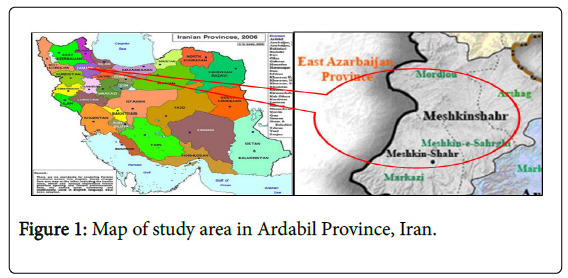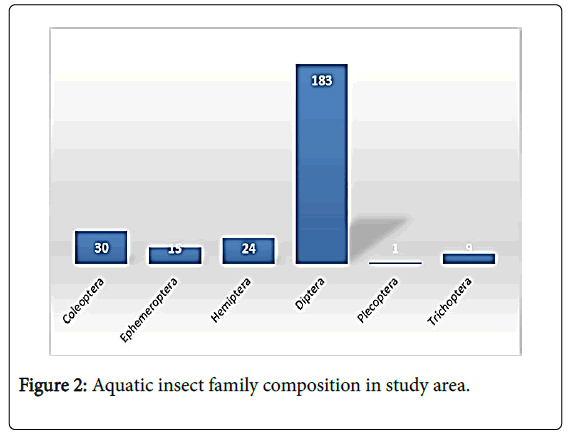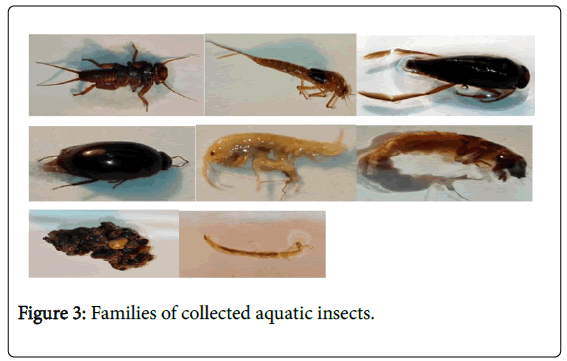Research Article Open Access
Aquatic Insects Fauna of Meshkin Shahr, Ardabil Province, Northwestern Iran, 2014
Shayeghi Mansoreh, Moradi Asl Eslam, Saeidi Zahra, Mozafari Ehssan, Poudat Abbas, Salimi Mojtaba and Vatandoost Hassan*Department of Medical Entomology and Vector Control, School of Public Health, Tehran University of Medical Sciences, Tehran, Iran
- *Corresponding Author:
- Vatandoost Hassan
Department of Medical Entomology and Vector Control
School of Public Health, Tehran University of Medical Sciences
Tehran, Iran
Tel: +98912-1594182
E-mail: hvatandoost1@yahoo.com, vatano@tums.ac.ir
Received date: June 09, 2006; Accepted date: August 18, 2016; Published date: August 25, 2016
Citation: Mansoreh S, Eslam MA, Zahra S, Ehssan M, Abbas P, et al. (2016) Aquatic Insects Fauna of Meshkin Shahr, Ardabil Province, Northwestern Iran, 2014. J Marine Sci Res Dev 6:206. doi:10.4172/2155-9910.1000206
Copyright: © 2016 Mansoreh S et al. This is an open-access article distributed under the terms of the Creative Commons Attribution License, which permits unrestricted use, distribution, and reproduction in any medium, provided the original author and source are credited.
Visit for more related articles at Journal of Marine Science: Research & Development
Abstract
The study was carried out in Wolaita, Hadya, Dawuro zone and Konta Special Woreda. The study was used household and key informant interview. The objective of the study was assessment of major opportunities and constraints of Honey production in central zones of SNNPR. Availability of ready and eager beekeepers to follow modern technology path way, availability of natural forest with adequate apiculture flora and water resource, availability of natural forest with adequate apiculture flora and water resource, existence of strong bee colony and a number of colonies, diversity and seasonal availability of bee forages and market access are some of opportunities of Honey production in the area. The major constraints of apiculture farming identified in the study districts comprised of lack of technical knowhow of small scale farmer, prevalence of honey bee enemies, lack of improved apiculture equipments, lack of improved honeybee flora, little attention given to apiculture development and technology introduction in the sector, lack of market oriented apiculture farming system and market information problem and others. The remedial measures for listed constraints of apiculture farming in the region recommended includes capacity building of small scale farmers, value chain analysis and value chain development adoption, pre-scaling up of proven apiary technologies and establishment of market oriented farmers apiary cooperatives.
Keywords
Aquatic insects; Faunistic; Meshkin Shahr; Iran
Introduction
Aquatic insects are a group of arthropods that can live in freshwater and brackish water successfully with spending at least one stage of their life cycle in water. Actually more than 30,000 species of aquatic insect have been identified which live in freshwater and only several hundred are living in marine environments [1]. Vast majority of insect spend their primary stage in water while adults are terrestrial, for instance orders of Ephemeroptera (Mayfly), Odonata (Dragonfly and Damselfly), Plecoptera (Stonefly), Trichoptera (Caddiesfly), Megaloptera (Alderfly), Neuroptera (Lacewings), Diptera (Flies), Lepidoptera (Moths) and Hymenoptera (Wasps). There are some species of Coleoptera (Beetle) and Hemiptera (Bug) mentioned as fully aquatic that larval, nymphal and adults stage exist in water [2]. Semi aquatic insect are related to semi aquatic and aquatic vegetation, the habitat of water margin and water surface [1]. Some of aquatic insects play an important role in transmitting diseases such as Malaria, Yellow fever, Dengue, Filariasis and some other Arboviral diseases [3]. Some of them like dragonfly and damselfly can be the host of termatodes [4]. A few of them have physical and mental annoyance and dermal damage on human and animal host by painful bite [5]. Some aquatic insects play a vital role as water recourse contamination indicators (e.g. Ephemeroptera, Plecoptera and Trichoptera (EPT)). The number of EPT species is mentioned as “Biological indicator “of water quality [6]. Water quality evaluation is performed by comparing of intolerant and tolerant species [7]. Some of theme in primary stages is used in toxicological investigation [1]. In freshwaters aquatic insects have critical function in nutrient recycling and decomposition [8]. They act by various functions as shredders, scrapers, filter feeders and predators. Some of them are very important in trophic dynamics, energy flow and food chain such as Trichopteran [9] and one of the main food source for amphibian and fishes [2] in this way they play an important role in ecosystem. Because of the scarcity of fauna and biodiversity studies of aquatic insects in Iran we decided to conduct a survey in Ardabil province, Meshkin shahr, northwestern Iran and attempt to open a new window to vast aquatic insects' world.
Materials and Methods
This study was conducted on Sablan River located in Meshkgin shahr towne in Ardabil province, in the northwestern of Iran. The river turns into a small river and a branch enter in to the Parikhan village and other branches located in the village of Kojanaq. Meshkin Shahr is located at the hillside of Sabalan so over the years is it has plenty of warm and cool of water (Figure 1).
Collection methods
Several methods were used to collect samples D-frame nets, dipping and direct search on the stones of river floor stones. Different habitats in rivers were studied (full and partial sunlight, shaded, with and without vegetation, as well as in fast and slow flow). Specimens were picked up using forceps and placed in glass jars with labels and preserved in Ethanol. Labels indicate the sampling site and date of collection. All collected samples were identified using morphological characteristics of standard keys [2].
Study area
Ardebil province is one of the thirty-one provinces of Iran. It is in the northwest of the country, in Regions 3, bordering the Republic of Azerbaijan, the provinces of East Azerbaijan, Zanjan, and Gilan. The province is divided into 10 counties: Ardabil, Bilasavar, Germi, Khalkhal, Kowsar, Meshkin Shahr, Namin, Sarein, Nir, and Parsabad. One of the most ancient city in Iran, is Meshkin Shahr. It is located in the north-west of Iran in Ardebil and its distance to Tehran is 839 kilometers. It is the nearest city to the Sabalan high mountain. The weather of this city and the district of Meshkin Shahr is moderate mountainous. Its coordinates are 38°30'0" N and 47°49'60" E in DMS (Degrees Minutes Seconds) or 38.5 and 47.8333 (in decimal degrees) (Figure 2).
Results
Totally, 262 samples were collected belonging to 6 orders (Coleoptera, Ephemeroptera, Hemiptera, Diptera, Plecoptera and Trichoptera) and 12 families (Elmidae, Leptophlebiidae, Ecdyonuridae, Corixidae, Culicidae, Simulidae, Perlidae, Leptoceridae, Hydropsychidae, Chironomidae, Caenidae and Baetidae) (Table 1). The most predominant family were Culicidae (Culicidae (50%) and (Plecoptera: Perlodidae) has the lower population size (0.5%). The identified species are listed in Table 1. In this study, the Diptera order are dominant with 183 (61/44%) and Plecoptera least order of 1 (0.05%). 75/5% samples collected were nymphs or larvae and 24/5% adults. 4 families were collected from ephemeroptera order and 3 families from diptera order. One or two families were collected from another order (Figure 3) (Table 1).
| Percentage% | Nymph/ Larvea No. | Adult No. | Total No. | Family | Order | NO. |
|---|---|---|---|---|---|---|
| 11.5 | - | 30 | 30 | Elmidae | Coleoptera | 1 |
| 0.05 | 1 | - | 1 | Leptophlebiidae | Ephemeroptera | 2 |
| 1.15 | 3 | - | 3 | Ecdyonuridae | 3 | |
| 0.05 | 1 | - | 1 | Cenidae | 4 | |
| 4 | - | 10 | 10 | Baetidae | 5 | |
| 9.5 | - | 24 | 24 | Corixidae | Hemiptera | 6 |
| 8.5 | 21 | - | 21 | Chironomidae | Diptera | 7 |
| 50 | 132 | - | 132 | Culicidae | 8 | |
| 11.5 | 30 | - | 30 | Simulidae | 9 | |
| 0.05 | 1 | - | 1 | Perlidae | Plecoptera | 10 |
| 0.05 | 1 | - | 1 | Leptoceridae | Trichoptera | 11 |
| 3.5 | 8 | - | 8 | Hydropsychidae | 12 | |
| 100 | 198 | 64 | 262 | - | Total | 13 |
Table 1: Aquatic insects collected from the various sampling sites, Sabalan Rivers, 2014.
Discussion
This study provides the first formal data with regard to the aquatic insects’ fauna in a part of Sablan River in Ardabil province, Iran. In the present study, were collected various species belonging to aquatic insects. Total number of 262 samples identified to 6 Orders and 12 families by using microscope. This study compared to other studies of species diversity is more. Diptera order with 50% of collected sample was the most abundance frequent.
At study that by shayeghi et al. accomplished in Zayande Roud River, Diptera order includes over 50% samples. Shayeghi et al. [10] Culicidae family were maximum groups in this study that Mousakazemi et al. [11] and Abai et al. [12] also found the same results. The orders Trichoptera and Plecoptera whit the lowest frequency in this study. In a recent investigation, one familie of Plecoptera and one family of Trichoptera were identified: Perlidae and Leptoceridae. In similar research Perlodidae was reported from the north of Iran but Perlidae not collected [13]. But the study Shayeghi et al. [10], predominant family and genus were Perlidae (49.7%) and Perla (49.7%) belonging to Plecoptera order. Coleoptera order was one of the abundance collected aquatic insect (11/5%) in our study that research conducted by Shayeghi [14] were agree with our results [10]. The only one family (Elmidae) of Coleoptera order was gathered. Riffle beetles in the family Elmidae are frequent members of the invertebrate community of running water. This family of coleoptera identified in a study Varnosfaderany 2008 in Zayandeh Rud River, Iran. The order Ephemeroptera (common name may fly) which was identified in this study is one of the most archaic of winged insect groups. Mayflies (Ephemeroptera) play an important role in almost all undisturbed freshwater communities and their larvae frequently form a considerable part of the material sampled during biomonitoring procedures. In the present study 3 families identified from ephemeroptera order [15-20] (Table 1).
Baetidae is a family of mayflies which was identified in this study. This family has been reported from saline habitats such as the wetlands of the Zarrineh estuary at the south of Urmia Lake in northwestern Iran. Leptophlebiidae, Ecdyonuridae and Cenidae are another families of Ephemeroptera collected in this study. Two of families were reported from Kashan Rivers, and one family were reported from Large River, in Central Iran. The Heteroptera are a group of about 40,000 species of insects in the order Hemiptera. Sometimes called (true bugs). The aquatic Hemiptera have excellent and frequently wonderful adaptations to their environment, exhibiting among them most mar velous variability of construction for their life in or on the water. The local, strictly aquatic species, belong to 10 families of the heteropterous Hemiptera. In this study one family (Corixidae) were collected. In contrast this study no family collected in Zayandeh Rud River and Large River.
Conclusion
In our research, 6 order and 12 families collected in stady area. Abundance of aquatic insects in these areas represents the food in the river are high. Furthermore, can be used for biological control of aquatic insects.
Acknowledgement
This research was financially supported by School of Public Health, Tehran University of Medical Sciences (TUMS). The authors would like to express our appreciation to the people of villages of near Meshkin shahr Cities for their kind cooperation through the study.
References
- Merritt RW, Cummins KW (1996) An introduction to the aquatic insects of North America p: 862.
- Subramanian KA, Sivaramkrishnan KG (2015) Aquatic Insects of India- A Field Guide. India Biodeversity.
- Foil LD (1989) Tabanids as vectors of disease agents. Parasitol Today 5: 88-96.
- Chae SJ, Pusterla N, Johnson E, Derock E, Lawler SP, et al. (2000) Infection of Aquatic insects whit Trematodemetacercariae carry Ehrlichiaristicii, the case of potomac house fever. J Med Entomol 37: 619-625.
- Villiers De (1987) Simulium dermatitis in man-clinical and biological features in South Africa. A case report. S Afr Med J 71: 523-525.
- Compin A, Cereghino R (2003) Sensitivity of aquatic insect species richness to disturbance in the Adour-Garonne stream system (France). Ecological Indicators 3: 135-42.
- Voshell JR (2002) A guide to common freshwater invertebrates of North America. Blacksburg, Virginia: McDonald and Woodward Publishing Company pp: 1-456.
- Balachandran C, Dinakaran S, Chandran MS. Diversity and Distribution of Aquatic Insects in Aghanashini River of Central Western Ghats, India.
- Malekei-Ravasan N, Bahrami A, Shayeghi M, Oshaghi MA, Malek M, et al. (2013) Notes on the Iran Caddisflies and Role of AnnulipalpianHydropsychidCaddisflies as a Bio-monitoring Agent, J Arthropod-Borne Dis 7: 71-82.
- Shayeghi M, Vatandoost H, Gorouhi A, Sanei-Dehkordi A, Salim-Abadi Y, et al. Biodiversity of Aquatic Insects of ZayandehRoud River and Its Branches, Isfahan Province, Iran, J Arthropod-Borne Dis 8: 197-203.
- Mousa-kazemi SH, Zaim M, Zahraii A (2000) Fauna and ecology of Culicidae of the Zarrin-Shahr and Mobarakeh area in Isfahan Province. ArmaghanDanesh. J of Yasuj University of Med Sci 5: 46-54.
- Abai MR, Azari-Hamidian S, Ladonni H, Hakimi M, Mashhadi-Esmail K, et al. (2007) Fauna and checklist of mosquitoes (Diptera: Culicidae) of East Azerbaijan Province, northwestern Iran. Iran J Arthropod- Borne Dis. 1: 27-33.
- Abbaspour R, Hedayatifard M, AlizadehSabet H (2013) Bioassessment of Macrobenthic Fauna of the CheshmehKileh River, Northern Iran. Am Eur J Agric Environ Sci 13: 747-53.
- Shayeghi1 M, Nejati1 J, Shirani-Bidabadil L, Koosha M, Badakhshan M, et al. (2015) Assessing the fauna of aquatic insects for possible use for malaria vector control in large river, Central Iran, ActaMedicaIranica.
- Mohammad, NematiVarnosfaderany, EsaEbrahimi, NoorollaMirghaffary, AlirezaSafyanian (2010) Biological assessmen to the ZayandehRud River, Iran, using benthic macroinvertebrates, Limnologica 40: 226-232.
- Bauernfeind E, Moog O (2000) May flies (Insecta: Ephemeroptera) and the assessment of ecological integrity: a methodological approach, Hydrobiologia 422: 71-83.
- Vafaei R, Ostovan H, Inchekar U, Pesic V (2007) Faunestic study of the aquatic beetles (Coleoptera: polyphaga) of Markazi province (central Iran) with new records. Arch BiolSci, Belgrade 59: 239-242.
- Dehghani R, Miranzadeh MB, Yosefzadeh M, Zamani S (2007) Fauna aquatic insects in sewage maturation ponds of Kashan University of Medical Science 2005. Pak J BiolSci 15: 928-931.
- Barber HG (1913) Aquatic Hemiptera, Journal of the New York Entomological Society pp: 29-32.
- Malcolm Elliott J (2008) The ecology of riffle beetles (Coleoptera: Elmidae), Freshwater Reviews pp: 189-203.
Relevant Topics
- Algal Blooms
- Blue Carbon Sequestration
- Brackish Water
- Catfish
- Coral Bleaching
- Coral Reefs
- Deep Sea Fish
- Deep Sea Mining
- Ichthyoplankton
- Mangrove Ecosystem
- Marine Engineering
- Marine Fisheries
- Marine Mammal Research
- Marine Microbiome Analysis
- Marine Pollution
- Marine Reptiles
- Marine Science
- Ocean Currents
- Photoendosymbiosis
- Reef Biology
- Sea Food
- Sea Grass
- Sea Transportation
- Seaweed
Recommended Journals
Article Tools
Article Usage
- Total views: 13057
- [From(publication date):
specialissue-2016 - Mar 31, 2025] - Breakdown by view type
- HTML page views : 12077
- PDF downloads : 980



